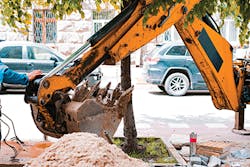Latest from Network Transformation/Edge Compute/IoT/URLLC/Automation/M2M
AI Digs Into Underground Fiber Damage Prevention
At Tesla AI Day in August 2021, CEO Elon Musk revealed the Tesla Bot, a robot prototype intended to "eliminate dangerous, repetitive, and boring tasks." Though faceless, the bot is human-like, with the form of an average- height, slim male.
The Tesla Bot is what many people picture when they think of artificial intelligence (AI). Westworld, Blade Runner, The Terminator, The Matrix, Ex Machina — the list of films featuring AI characters, good and bad, goes on and on.
But AI technology is generally more inconspicuous than science fiction would have you believe. Yes, Boston Dynamics has created robots that can dance and even perform parkour, but the everyman’s AI technology is significantly more low-key. It’s Google auto filling your search query, or Netflix suggesting shows you might enjoy.
According to Gartner, the number of global enterprises using AI in some capacity has increased 270% in just 4 years. This surge is due, in large part, to the availability of endless amounts of data. And while data is plentiful, it must be examined closely to find useful insights, and it must be processed quickly in order to act on those insights in a timely manner. AI does both, enabling people to work faster and make more informed decisions.
AI Digs Into Telecom
Telecom providers can apply AI technology to help solve a number of pressing business challenges. This article discusses one use case: preventing fiber cuts and other underground cable damage.
Damages to US underground infrastructure are up 4.5% year-over-year to 532,000, according to the Common Ground Alliance’s 2019 DIRT Report. Telecommunications facilities are damaged most frequently, making up nearly half (45%) of total damages.
According to the report, telecoms paid a median price of $600 million in direct facility repair costs and $18 billion in indirect costs.
Of course, money isn’t the only consequence of underground cable damage. Fiber cuts often result in service outages, which can lead to customer backlash and churn. A provider’s public image can also take a hit, particularly if an outage garners significant media coverage.
For example, take the outage that shut down Virginia’s voter registration system on the last day Virginia residents could register to vote in the November 2020 general presidential election. According to the Washington Post, the system was down for more than 5 hours and also affected online services provided by the state Department of Motor Vehicles and Department of Health, among other agencies.
Preventing fiber cuts and other underground cable damage is a huge challenge, for 2 primary reasons.
First is increased excavation activity. According to U.S. Census data, total construction spending rose 80% from 2010 to 2020. Following a decline in activity in early 2020, spending is up again, with $1,552.2 billion spent in June 2021, according to the Census Bureau. And with Congress expected to pass a $1 trillion infrastructure bill (at the time of writing this article), construction is likely to accelerate sharply, putting underground assets at greater risk.
Second, telecom providers have a limited number of staff dedicated to damage prevention. Damage prevention professionals are inundated with 811 tickets, making it near impossible to carefully and quickly examine a ticket’s details to determine whether white lining, or more involved damage prevention techniques like dispatching inspectors, is necessary.
Furthermore, they have no opportunity to protect underground assets from excavators who don’t follow 811 laws because they have no way of anticipating where unsafe excavations are likely to happen. Failure to notify the One Call center makes up nearly 30% of underground asset damages, according to the 2019 CGA DIRT Report, demonstrating the strong need to find a solution to no call-ins.
Prevention Is The Key
Damage prevention software that leverages AI technology can help solve the challenges of protecting buried fiber optic cable from excavation accidents.
AI-powered damage prevention software reviews all of a telecom provider’s 811 tickets to determine the projects where fiber cuts and similar excavation accidents are most likely to occur.
The software also identifies where the consequences of accidents would be the most severe, like excavations near hubs or fiber bundles where damage could affect thousands of customers.
The software makes its predictions by analyzing a telecom provider’s internal facility data — including location, type, and historical incident data — as well as relevant real-world weather, environmental, community, and other, data. It assigns risk levels to every 811 ticket, surfacing those with the highest risk, so telecom damage prevention professionals can prioritize them for intervention, whether that’s a phone call to the excavator or sending a specialist on-site to oversee work.
A distinct advantage of AI is that it "learns" as it ingests new data, adapting algorithms as a telecom provider records new outcomes and as infrastructure, operations, and surrounding environments, change. For example, 811 tickets associated with an excavating company that has improved their damage track record following on-site interventions receives a lower risk level over time. This helps ensure a telecom provider is receiving insights that accurately reflect what’s happening in the field.
As for no call-ins, some damage prevention solutions, notably Urbint Lens for Damage Prevention, use leading indicators like construction activity to anticipate unreported excavations. With this information, telecom providers can better target their 811 awareness campaigns, or even urge local politicians to toughen penalties for excavators who repeatedly violate 811 laws.
AI is a transformative technology with vast potential in the telecom industry. Energy companies like National Grid, Southern Company, Dominion Energy Inc. and Con Edison, use AI software to aid in their damage prevention efforts — and have experienced fewer damages to their underground assets as a result. Now, it’s time for telecom providers to do the same.
By implementing AI technology, telecom providers can better utilize the myriad of data they collect to address the long-standing challenge of damage prevention while continuing to provide reliable, affordable service to customers.
Resources And Notes
https://www.census.gov/construction/c30/historical_data.html
https://www.census.gov/construction/c30/pdf/release.pdf
https://www.urbint.com/solutions/urbint-lens-for-damage-prevention
Fiber Investment Forecast: More than $60B in Next Five Years for FTTH
For more information, please email [email protected], visit https://www.urbint.com/, and follow us on Twitter @urbint. Follow Corey on LinkedIn.
Like this Article?
Subscribe to ISE magazine and start receiving your FREE monthly copy today!








